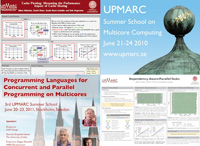Power modeling
More information: Uppsala Architecture Research Team | Power Modeling
| Power Modeling and DVFS Optimization
and DVFS Optimization .
.
Motivation
Power dissipation has become an important design constraint, on par with performance, in the design of every computer system. It has also been a major factor behind the switch to multicore architectures. Over the past decade a large number of power optimizations have been proposed but it is becoming exceedingly difficult to evaluate them in the context of multicores. Typically, simulation has been used for this job, but it is now too slow to capture the complex interaction of power optimizations in such an environment. We are developing techniques based on a new class of analytical modeling called interval modeling and extend it to describe many important power optimizations. In addition, we are developing techniques to accurately measure power of real processors at a very fine time resolution. Using interval-based power models, statistical approaches to describe the dynamic behavior of programs, and real power measurements allows us to explore a vast design space in terms of power-efficiency. We aim to use this exploration to tailor multicore power management facilities individually to each application, and to optimize applications at the source code level for power-efficiency. In addition we explore new execution paradigms such as Decoupled Access-Execute that can be tailored to increase the efficiency of DVFS.


Interval-based models to describe DVFS. Loss of performance is due to "miss events." Out of many types of miss events the last level cache misses, i.e., accesses to the slow main memory, are the ones that can be affected by frequency scaling.

Applying the models on real applications yields near-optimal frequencies for power-efficiency metrics (EDP and ED2P). We are currently performing this dynamically at run time by continuously predicting optimal frequency and voltage.


An enabling methodology that allows us to apply our theoretical models on real machines are the accurate, high-resolution, fine-grain, power measurements on real systems. The picture shows our power measurement probes directly on the voltage regulators of an Intel i7 motherboard.
Long Term Goal
Develop power consumption models and apply them to dynamically optimize the power efficiency of multicores, GPGPUs and memory systems, both for stand-alone systems and for large-scale clusters (warehouse computing, data centers, cloud computing, HPC). Develop new execution paradigms for efficient execution. Develop simulation and measurement infrastructure to explore power efficiency.
Explore upcoming nanotechnologies for beyond the End of Moore.
Expected Results
Analytical models for power consumption that can effectively drive the power management of multicores.
Achievements
- Interval-based DVFS model that describes a change of operating frequency as a change of the memory latency in cycles. Application on real systems.
- Power-Sleuth Tool to explore program behavior (performance and power) for all DVFS settings with only a single profiling run
- Power models correlating effective capacitance of contemporary processors with performance counters
- Simulation infrastructure (gem5) for multiple-domain DVFS (collaboration with ARM LTD.)
- Development of new execution models for task-based programming to increase the effectiveness of DVFS (Decoupled Access-Execute model)
- Automatic compiler support for generated decoupled access-execute code
- High-end GPU power and slack measurements
- Exploration of the power-efficiency of nanowrire transistors
Publications
- Alexandra Jimborean, Konstantinos Koukos, Vasileios Spiliopoulos, David Black-Schaffer, and Stefanos Kaxiras. "Fix the code. Don't tweak the hardware: A new compiler approach to Voltage–Frequency scaling." In Proc. 12th International Symposium on Code Generation and Optimization, IEEE Computer Society, 2014.
- Konstantinos Koukos, David Black-Schaffer, Vasileios Spiliopoulos, and Stefanos Kaxiras. "Towards more efficient execution: A decoupled access-execute approach." International Conference on Supercomputing (ICS), 2013.
- Konstantinos Koukos, David Black-Schaffer, Vasileios Spiliopoulos, Stefanos Kaxiras. "Towards Power Efficiency on Task-Based, Decoupled Access-Execute Models." Workshop on Parallel Programming and Run-Time Management Techniques for Many-core Architectures (PARMA), 2013.
- Vasileios Spiliopoulos, Andreas Sembrant, Stefanos Kaxiras "Power-Sleuth: A Tool for Investigating Your Program's Power Behavior," In Modeling, Analysis & Simulation of Computer and Telecommunication Systems (MASCOTS), 2012 IEEE 20th International Symposium on, pp. 241-250. IEEE, 2012.
- Vasileios Spiliopoulos, Stefanos Kaxiras, Georgios Keramidas "Green Governors: A Framework for Continuously Adaptive DVFS," 2nd International Green Computing Conference, Orlando, Florida, USA, July 25-28, 2011.
- Juan M. Cebrián, Juan L. Aragón and Stefanos Kaxiras "Power Token Balancing: Adapting CMPs to Power Constraints
for Parallel Multithreaded Workloads," IEEE Parallel and Distributed Processing Conference (IPDPS), May 16-20, 2011.
- Juan M. Cebrián, Juan L. Aragón and Stefanos Kaxiras "Token3D: Reducing Temperature in 3D die-stacked CMPs
through Cycle-level Power Control Mechanisms," EuroPar, 2011.
- Vasileios Spiliopoulos, Georgios Keramidas, Stefanos Kaxiras and Konstantinos Efstathiou "DVFS Management in Real-Processors" (Poster) International Conference on Supercomputing, 2011.
Approach
Our approach is based on:
- developing analytical models to describe program and hardware behavior
- using real-hardware measurements to verify and calibrate the analytical models
- incorporating the analytical models into simulation infrastructures (e.g., gem5)
- developing new simulation power models for upcoming nanoarchitectures
Staff
Senior: Stefanos Kaxiras (Contact)
Collaborating: David Black-Schaffer, Erik Hagersten, Alexandra Jimborean
Ph.D. students: Vasileios Spiliopoulos
Konstantinos Koukos, Mahdad Davari
M.Sc. Students: Magnus Anders-Norgren





